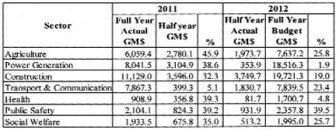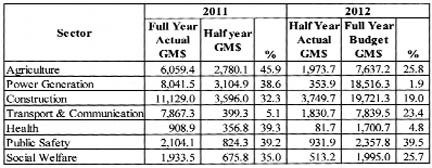Conclusion
In the introduction to last week’s Business Page I pointed out that it was refreshing that the mid-year report was not only prepared within the statutory deadline but that the report was actually made public even before it was laid in the National Assembly which is presided over by the Speaker. That was certainly one step forward. Just one week later the Auditor General presented to the Speaker of the National Assembly the audit report for 2011within the statutory deadline. This was the first time that this was done under Mr Deodat Sharma as the Head of the Audit Office. And guess what the Speaker does? He not only drew comparison with what last took place twenty-one years ago, but then goes on to confuse his specially assembled audience over the timing of the submission of reports since that date. And to add vinegar, he announced that the report will be locked away until the National Assembly resumes from its prolonged recess. That certainly is not a forward step.
 Last week as we reviewed the sectoral performance of the economy we saw the up-and-down performance of its major sectors even as it recorded overall growth. We also looked at the values of imports and imports and the change in the consumer price index which is popularly referred to as the inflation rate. Today we turn attention to other segments of the report and begin with revenues.
Last week as we reviewed the sectoral performance of the economy we saw the up-and-down performance of its major sectors even as it recorded overall growth. We also looked at the values of imports and imports and the change in the consumer price index which is popularly referred to as the inflation rate. Today we turn attention to other segments of the report and begin with revenues.
Revenues
Central government revenue for the first half of 2012 amounted to $64.9 billion. While representing only 44% of the budgeted revenue for the year, the collections represented a 5.5 % increase over first half 2011, primarily as a result of improved performance across several tax revenue categories. Tax revenue collections for the period amounted to $58.6 billion representing 90.4% of total current revenue collections or 2.9% over 2011.
Internal revenue collections for the half-year amounted to $25.9 billion compared to $26.5 billion in 2011, a decline of 2.3%, as a result of contractions of $582.2 million and $146.6 million in private and public sector corporation taxes respectively. The Minister attributed this decline to lower company tax rates, a bit of a stretch since tax rates were reduced not in 2012 but in 2011, and tax payments to June 30, 2011 would have taken the reduced rates into account last year.
A more realistic explanation lay in withholding tax collections which decreased by $624.8 million compared to first half 2011 due to arrears in dividend payments made in 2011 by a local company to its overseas parent company.
Customs and trade tax collections totalled $5.7 billion for the first half, representing a 19.6% or $930.9 million increase over 2011 half-year collections. The minister attributed this to a $900.6 million increase from import duties due to higher level of imports of most categories of goods particularly intermediate goods. Excise tax collections for the period amounted to $11 billion, a slight fall from 2011. Excise tax collections from motor vehicles amounted to $5.2 billion, an increase of $1.5 billion reflecting higher levels of vehicle imports.
Collections of value added tax (VAT) for the half-year amounted to $16.1 billion, an increase of $1.4 billion. VAT on imports of goods and services accounting for $611.7 million of the increase while VAT on domestic supplies increased by $831.1 million. Value-added tax for the full year was budgeted at $33.968 billion.
Tax evasion
Taxes collected from the self-employed amounted to a mere $1.8 billion to the revenues, compared to $1.5 billion for same period in 2011. As a percentage of tax revenues the self-employed – who dominate the professions, agriculture, fishing, car dealers, goldsmiths, artisans, contractors and most of the main shopping areas in all three counties – contribute less than 2.6% of the tax revenues of the country.
We have heard nothing recently of the so-called tax review committee announced by President Ramotar almost ten months ago, a delay that perpetuates a lop-sided, regressive tax-system in which the self-employed continue to treat taxation as a voluntary matter rather than be treated as the criminals that they are.
No Minister of Finance since 1992 has treated tax evasion seriously but all, including Dr Ashni Singh and his appointed Board of the Guyana Revenue Authority, continue to ignore the glaring statistics that show how serious and damaging the situation has become. Imports by the self-employed continue to rise by double digits, with bank deposits and import taxes not far behind. Yet the taxes the self employed merchants including our newest friends and the rest of the self-employed sector pay, move up only imperceptibly.
With all the inherent problems the GRA faces, it is quite remarkable that the taxes collected by it continue to rise. Whatever we may think of the nature of the tax system and the systemic corruption in some segments of the GRA, those of us who have to deal with the Authority on a day-to-day basis cannot help but admire – and feel a bit sorry for – the many hardworking staff who have to deal with a taxation public made up of so many groups of prominent tax evaders and money launderers.
Missing GRIF and other monies
In paragraph 3.34 of the mid-year report the Minister states that “based on developments in the first half of the year, total current revenue collections (net of GRIF inflows) are now estimated at $128.7 billion for the full year.” A review of Appendix E1 shows that while the sum of $18.4 billion was budgeted to be received, that amount has now been revised downwards to $1.975 billion. Since the Norwegian funds accounted for 15% of budgeted revenue for this year and since many of the LCDS projects were framed around the Norway funds, it was reasonable to expect that the Minister would say something of substance about the status of those funds.
Absent from revenue projections too are monies from the Lottery and the proceeds from the disposal of state assets by NICIL for sundry purposes.
Current expenditure
On the expenditure side total non-interest current expenditure to June 2012 amounted to $43.8 billion, an increase of 14.3% over the same period in 2011. This sum represents 41% of the budgeted expenditure for 2012.
The several types of expenditure where there were increases in 2012 over 2011 included statutory pensions and gratuities which had a 38% increase (no explanation offered); total other charges which increased by 11%; and subsidies and contributions to local organisations – mainly Guyana Power and Light Inc – which increased from $5.8 billion in half-year 2011 to $10.3 billion (77.6%) in the corresponding period in 2012. Old Age Pensions and Social Assistance payments in 2012 amounted to $2.4 billion compared with $1.98 billion in the corresponding half year in 2011.
While the late presentation and passing of the 2012 budget may have been responsible for a number of categories of expenditure to be lower than those for 2011, their greater significance lay in the percentages which the half-year 2012 expenditure bear to the full-year budget. Not unusually, the entire amount of $$3.7 billion for revision of wages and salaries remains unspent.
If we look further at the item Other Charges, which includes several categories of expenditure, we note that only $26.3 billion was spent up to June 30, representing 37% of what is projected for the full year. Principal among the items which had disproportionate spending in the first half of 2012 are expenditure on Materials and Supplies which represents 34% of full year projections; Rental and Maintenance of buildings18.7%; Maintenance of Infrastructure 14.5%; Transport, Travel and postage 34.3%; Utility charges 32.8%; Other Goods and Services 33.9%; Other Operational Expenses 30.1%; Education Subvention and Training 38.8%; Rates and Taxes and Subventions to Local Authorities 3.9%; and Pensions 42.5%.
The situation is no different with the capital expenditure side of the accounts.
Sectoral Capital Expenditure
 What we may see and need to fear is that there will be a mad rush to spend in the second half of the year with continued negative consequences for quality and value for money as well as controls over public expenditure.
What we may see and need to fear is that there will be a mad rush to spend in the second half of the year with continued negative consequences for quality and value for money as well as controls over public expenditure.
Deficit and debt
The overall deficit before grants is projected at $43.5 billion, almost certainly the largest budget deficit in the country’s history, measured by absolute amount as well as a percentage of revenue. Even after projected grants of $16.8 billion, the country will need financing of $26.6
billion which will have to come from borrowings. By June 2012, the external debt had increased to US$1.3 billion, 7.6% more than the amounts owing at December 31, 2011. During the first half of 2012, external debt service totalled US$20.4 million, an increase of 10.8% compared to the same period in 2011.By December 31, 2012 the combined external and domestic debt stock will exceed the psychological US$2 billion threshold.
Conclusion
It is evident that the economy’s growth rate in 2012 was lower than in 2011. But perhaps because the Minister had projected for lower real growth in full year 2012, he concluded his report with some reassurance, if not confidence, that the performance of the first half of the year “augurs well for the remainder of the year.”
But acknowledging the events in Linden, his final words were directed not at his colleagues in his government or his ministry to implore them to exercise greater and better management, but at all national stakeholders to “ensure the preservation of the environment that is so critical for a continuation of this favourable performance, not just for the remainder of the year but into the medium term.”









